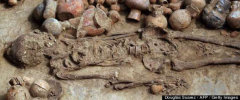
by: Scott Sutherland
Archaeologists digging in an ancient Peruvian tomb have unearthed a skeleton, confirming that a mysterious people known as the Moche were ruled by a succession of queens that presided over a brutal and ritualistic society.
Centuries ago, in the Sechura Desert of northern Peru — one of the most arid and brutal environments on our planet — the Moche people developed an equally-brutal culture. With no written history left behind, much of their society still remains a mystery, but paintings on pottery have shown researchers evidence of a rigid culture of survival, with ritualized combats where the losing side was sacrificed.
Findings in recent years expanded the tale of these people even further, telling a story of how they were ruled by women, priestesses who also acted as queens. The first of the discoveries that hinted at this possibility, apparently, was the Lady of Cao, a mummy unearthed from a tomb in 2006 that showed signs of dying during childbirth. The discovery of yet another priestess's skeleton, the latest of eight found so far, has confirmed this. The body was buried in an elaborate 1,200 year old tomb in Chepén, along with adult and child sacrifices.
"This find makes it clear that women didn't just run rituals in this area but governed here and were queens of Mochica society," said project director Luis Jaime Castillo, according to the Associated Free Press.
"It is the eighth priestess to be discovered," he added. "Our excavations have only turned up tombs with women, never men."
Another important find involved how the Moche culture disappeared.
Originally, it was thought that they died off due to a devastating climate upheaval — a 'mega-El Nino' that lasted for 30 years. Evidence in the mountains of northern Peru showed that, sometime between 560 and 650 A.D., there was 30 years of drought followed by 30 years of heavy rain and snow. It's known that when the mountains experience these weather conditions, the Sechura Desert gets the opposite effect, so the Moche would have been subjected to 30 years of rainy weather followed by 30 years of extreme drought.
However, recent evidence points to a more violent downturn for the Moche. They apparently survived the extreme shifts in climate, but with scarce resources left over in the aftermath, they turned on each other, exchanging their ritualized combats for a bloody civil war that eventually destroyed them.
(Photos courtesy: Douglas Suarez/AFP/Getty Images)

No comments:
Post a Comment